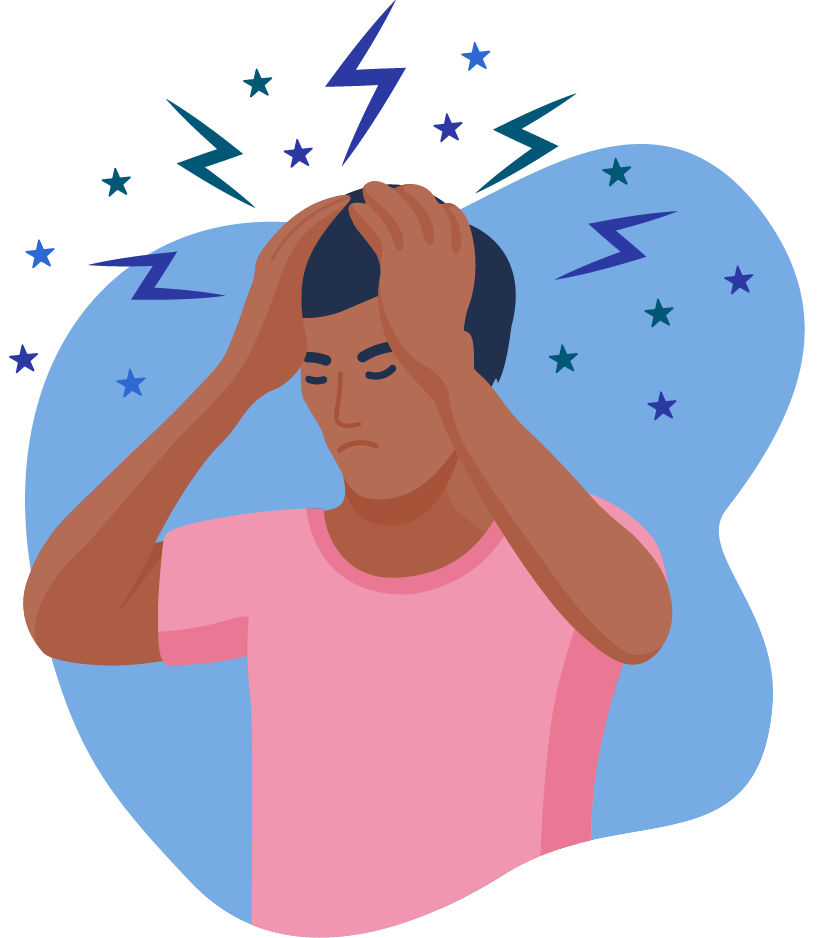
Quick Links
Resources
About MyMigraineTeam
Powered By






Cluster headaches are one of several types of headache disorders. (They are not a type of migraine.) Cluster headache is characterized by exceedingly painful, short-term attacks that affect one side of the body. They usually occur with involuntary symptoms of the face or a sense of restlessness and agitation — or both. These attacks often repeat throughout days or weeks with pain-free periods between active episodes. Cluster headaches have been reported as one of the most debilitating and painful conditions there is. The frequency of this type of headache can have major effects on a person’s quality of life.
Some studies suggest that environmental factors such as smoking, obesity, and use of recreational drugs are associated with the development or frequency of cluster headaches. Cluster headaches are thought to be caused by abnormal activity in:
Cluster headache may have a genetic component, as some types of headache are common within families.
Episodes of cluster headache are also related to circadian rhythms and sleep. During episodes, people living with cluster headache report a poor quality of sleep, especially in regions and during seasons that have long periods of daylight. It has been reported that low melatonin levels might influence cluster headache attacks. Overall, quality of sleep is decreased in both episodic and chronic cluster headaches. People living with episodic cluster headaches have a harder time coping with reduced sleep than the average person. And those with chronic cluster headaches have a difficult time changing their sleeping patterns. Further, people living with cluster headaches have different sleeping patterns than people who do not suffer from cluster headaches.
Cluster headaches are associated with episodic or chronic pain in the head, without an identifiable physical or functional cause. In other words, no disease or injury has caused it. Pain associated with cluster headaches may occur around the eyes, above the eyes, in the temples, around the side of the head, or in any combination of these locations. Many people living with cluster headaches actually seek help from their dentists due to the common symptoms of oral and/or facial pain.
Episodes of headache pain typically last anywhere from 15 minutes to three hours and have been reported as often as eight times per day. The shorter duration of cluster headaches is a distinguishing characteristic that separates the condition from another headache disorder: migraine. Cluster headaches often occur around the same time each day during periods of attack.
Other symptoms can include:
One study reported an impaired olfactory response (sense of smell) in people living with cluster headaches compared with healthy people.
About 1 in 1,000 adults in the United States have experienced a cluster headache attack. Most people living with cluster headaches report a negative impact on their ability to do daily activities. Unfortunately, not everyone living with cluster headaches has remission periods. When someone has a headache-free period, they are said to have “chronic cluster headache.” Episodic cluster headaches, which do include spells of remission, are more common than the chronic form.
Cluster headache is a chronic neurovascular disorder. A doctor can make a cluster headache diagnosis when a person meets a set of criteria established by the International Classification of Headache Disorders. Your health care provider seeks information about your history of attacks, accounts of involuntary symptoms (on the same side of the body as the headache pain), and the frequency and pattern of your attacks. Cluster headaches are somewhat more prevalent in men, and attacks usually develop between 20 and 40 years of age. Potential physical or functional causes of headache pain must be ruled out before cluster headache is diagnosed. Many people living with cluster headaches have experienced misdiagnosis or a long road to a final diagnosis. Obviously, a drawn-out diagnosis prolongs the time until they can have proper treatment and relief.
Researchers and health care professionals are working hard to find a cure for cluster headaches. The main goals of treatment of cluster headaches are to alleviate symptoms during an attack such as severe pain and take steps to avoid attacks during a period active with cluster headache. There are treatments for symptoms during episodes of acute headache and preventive treatments.
Treatment may include long-term prescription medications for people with chronic cluster headaches who do not experience remission. Treatment to alleviate symptoms during an episode usually consists of:
Preventive treatment focuses on identifying and avoiding attack triggers. Verapamil (branded as Verelan, Calan, Covera) is a commonly used preventive drug therapy, especially for people who do not experience remission.
In some cases where people do not respond or have severe side effects to first-line therapy, more acute treatments may be used. These can include nerve stimulation or deep brain stimulation (when specific nerves such as the occipital and vagus nerves or areas of the brain are stimulated to help relieve pain). Treatments for cluster headaches may have major side effects, not be tolerated well, or be ineffective. More acute treatments are likely to be prescribed for people living with chronic, severely painful, episodic headaches that are not relieved or prevented by other methods.
On MyMigraineTeam, the social network for people living with migraines and their loved ones, more than 76,000 members come together to ask questions, give advice, and share their stories with others who understand life with the condition.
Are you living with cluster headaches? What has your experience been like? Share your experience in the comments below, or start a conversation by posting on MyMigraineTeam.

Are your headaches a symptom of migraine? Get a quick assessment.
Sign up for free!
Become a member to get even more




A MyMigraineTeam Member
I have chronic migraines and a few years ago had SEVERE THUNDER CLAP headaches, labeled as that and Cluster.....wondering causes and are they migraine related....?? Unbelievable PAINFUL felt like an… read more